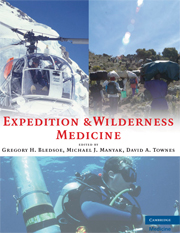Book contents
- Frontmatter
- Contents
- Contributors
- Foreword
- Preface
- Acknowledgments
- PART I EXPEDITION PLANNING
- PART II EXPEDITIONS IN UNIQUE ENVIRONMENTS
- PART III ILLNESS AND INJURIES ON EXPEDITIONS
- 24 General Medical
- 25 The Diarrhea of Travelers
- 26 Malaria: Diagnosis, Prevention, and Treatment for the Traveler
- 27 Wild Animal Attacks and Injuries
- 28 Snake and Arthropod Envenoming
- 29 Hazardous Marine Life
- 30 Expedition Toxicology
- 31 Environmental Injuries
- 32 Penetrating and Explosive Wounds
- 33 Drowning and Submersion Injury
- 34 Evaluation and Acute Resuscitation of the Trauma Patient
- 35 Principles and Practice of Expedition Wound Management
- 36 Expedition Eye Injuries and Disorders
- 37 Dental Medicine on Expedition
- 38 Foot Injuries
- 39 Expedition Orthopedics
- 40 Expedition Self-Rescue and Evacuation
- 41 Aeromedical Evacuations
- APPENDIX The Expedition Medical Kit
- Index
35 - Principles and Practice of Expedition Wound Management
from PART III - ILLNESS AND INJURIES ON EXPEDITIONS
Published online by Cambridge University Press: 05 March 2013
- Frontmatter
- Contents
- Contributors
- Foreword
- Preface
- Acknowledgments
- PART I EXPEDITION PLANNING
- PART II EXPEDITIONS IN UNIQUE ENVIRONMENTS
- PART III ILLNESS AND INJURIES ON EXPEDITIONS
- 24 General Medical
- 25 The Diarrhea of Travelers
- 26 Malaria: Diagnosis, Prevention, and Treatment for the Traveler
- 27 Wild Animal Attacks and Injuries
- 28 Snake and Arthropod Envenoming
- 29 Hazardous Marine Life
- 30 Expedition Toxicology
- 31 Environmental Injuries
- 32 Penetrating and Explosive Wounds
- 33 Drowning and Submersion Injury
- 34 Evaluation and Acute Resuscitation of the Trauma Patient
- 35 Principles and Practice of Expedition Wound Management
- 36 Expedition Eye Injuries and Disorders
- 37 Dental Medicine on Expedition
- 38 Foot Injuries
- 39 Expedition Orthopedics
- 40 Expedition Self-Rescue and Evacuation
- 41 Aeromedical Evacuations
- APPENDIX The Expedition Medical Kit
- Index
Summary
Author's Note: The topic of expedition wound management is, in itself, worthy of an entire publication. The inherent difficulty in writing this chapter is to determine which key elements of the subject are exclusive to expedition practice or merit further discussion and exclude those common in most quality wound management texts. The goal is not to burden the reader with a review of technical skills he or she should already possess or provide lists of wound care supplies that might be packed for the generic expedition. The rationale behind this chapter is to consider the overall approach to the wound care patient in the context of a remote setting.
All wounds can be more severe than a given first impression allows, even potentially life-threatening, therefore, “tunnel vision” must be avoided when assessing and treating the patient.
EXPEDITION VERSUS CONVENTIONAL WOUND MANAGEMENT
The treatment of acute traumatic wounds suffered during an expedition often demands a significant portion of the clinician's attention. The idea that the practice of wound management during an expedition might somehow be different than performed in a “brick and mortar” setting is, by no means, a revolutionary concept. It is easy to feel quite comfortable when closing a wound in a well-stocked, climate-controlled Procedure Room. It is another matter when your Procedure Room is a poorly lit tent, the galley of a ship, the bed of a pickup truck or, maybe, the floor of the closest four-walled structure. While the former environment is certainly preferable for most complicated cases, both settings are not without their advantages and disadvantages.
- Type
- Chapter
- Information
- Expedition and Wilderness Medicine , pp. 544 - 561Publisher: Cambridge University PressPrint publication year: 2008

